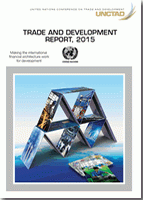
The Trade and Development Report (TDR) 2015: Making the international financial architecture work for development reviews recent trends in the global economy and focuses on ways to reform the international financial architecture. It warns that with a tepid recovery in developed countries and headwinds in many developing and transition economies, the global crisis is not over, and the risk of a prolonged stagnation persists. The main constraint is insufficient global demand, combined with financial fragility and instability, and growing inequality.
These trends reveal the lack of a well-functioning international monetary and financial system, which should be able to properly regulate international liquidity, avoid large and lasting imbalances and allow for counter-cyclical policies; however, international liquidity and capital movements respond to economic conditions in developed countries rather than to actual needs in developing countries. Furthermore, much of the current regime is in fact driven by large international banks and financial intermediaries whose activities increased much more rapidly than the capacity of any public institution (either national or multilateral) to effectively regulate it. Recent initiatives aiming at better regulation remain too timid and narrow.
This dysfunctional regime can neither prevent boom-and-bust episodes nor recurrent debt crises; and when such crises occur, it leads to asymmetric adjustment that throws most of the burden on debtor countries and exacerbates a pro-cyclical bias. This calls for a mechanism for debt resolution, in particular for sovereign external debt, which minimizes the cost of crisis and shares it fairly among the different actors. Furthermore, inefficiencies and missing elements in the international financial architecture have had negative effects in the provision of long-term finance for development.
Against this background, TDR 2015 identifies some of the critical issues to be addressed in order to establish a more stable and inclusive international monetary and financial system which can support the development challenges over the coming years. It considers existing shortcomings, analyses emerging vulnerabilities and examines proposals and initiatives for reform.
In order to improve global growth and financial stability, and to realize the investment push required to fulfil the new development agenda, the systemic problems of the international financial architecture need to be addressed. Solutions are available, but they require dedicated action by the international community.
The main recommendations of the Report are:
To avoid secular stagnation, developed countries need to combine monetary expansion with fiscal expansion and wage growth, and be mindful of the international spillovers that their policies can produce;
To make the provision of official international liquidity more stable and predictable, multilateral reform remains the desirable target - in the meantime, developing countries may build on regional and interregional initiatives, set swap arrangements among Central Banks and reduce the need for reserve accumulation;
A bolder regulatory agenda is needed. This should include strict separation of retail and investment banking, strong regulation of shadow banking as well as public oversight of credit rating agencies and their progressive substitution by more appropriate mechanisms for risk assessment;
Developing countries should not be required to apply prudential rules which have been conceived for countries hosting internationally active banks as they result in credit rationing to sectors and agents that need support from a development perspective;
A sovereign debt restructuring mechanism is urgently needed. This could be in the form of contractual improvements or internationally accepted principles to guide sovereign debt restructuring. However, the Report sees the best option in a statutory approach based on a multilateral treaty defining a set of rules for a debt restructuring that restores growth and debt sustainability;
Specialized public institutions and mechanisms are crucial for the provision of long-term development finance, in particular development banks. The international community needs to meet its Official Development Assistance commitments and to tune it better to strengthening the productive economy.


